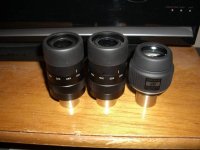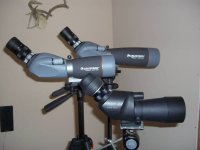FrankD
Well-known member
BCTD,
No problem at all answering the questions. This is actually one of my favorite parts to this hobby...finding a new product that performs way above expectations.

To answer some of your questions....they appear to be the same eyepiece...and, yes, with identical eye relief specifications...14 mm at 48x on the 65 mm. I can detect no difference physically between the two eyepieces. I finally found the digital camera and took some pictures. The first one I am going to include with this post is of the three eyepieces. The second picture will be of the three scopes and the last one was a handheld digiscoped shot (..have to find my large digiscoping adapter) through the 65 mm of an Indigo Bunting at approximately 20 yards. None of the pics were adjusted except to resize to fit in the forum. Some detail was lost because of this. Take note of the brightness, color representation and lack of CA in the Indigo bunting image (ignore the sharpness and "noise" as that is the fault of my digital camera and handheld "technique. )
)
To answer your question about the zoom tension....I would call it "perfect" on both scopes. It has that smooth "metallic" feel of precision parts moving together. It is firm enough not to move accidentally and yet moves freely enough when pressure is applied. Better mechanics than any of my previous zooms including the Baader clone.
No problem at all answering the questions. This is actually one of my favorite parts to this hobby...finding a new product that performs way above expectations.
To answer some of your questions....they appear to be the same eyepiece...and, yes, with identical eye relief specifications...14 mm at 48x on the 65 mm. I can detect no difference physically between the two eyepieces. I finally found the digital camera and took some pictures. The first one I am going to include with this post is of the three eyepieces. The second picture will be of the three scopes and the last one was a handheld digiscoped shot (..have to find my large digiscoping adapter) through the 65 mm of an Indigo Bunting at approximately 20 yards. None of the pics were adjusted except to resize to fit in the forum. Some detail was lost because of this. Take note of the brightness, color representation and lack of CA in the Indigo bunting image (ignore the sharpness and "noise" as that is the fault of my digital camera and handheld "technique.
To answer your question about the zoom tension....I would call it "perfect" on both scopes. It has that smooth "metallic" feel of precision parts moving together. It is firm enough not to move accidentally and yet moves freely enough when pressure is applied. Better mechanics than any of my previous zooms including the Baader clone.







